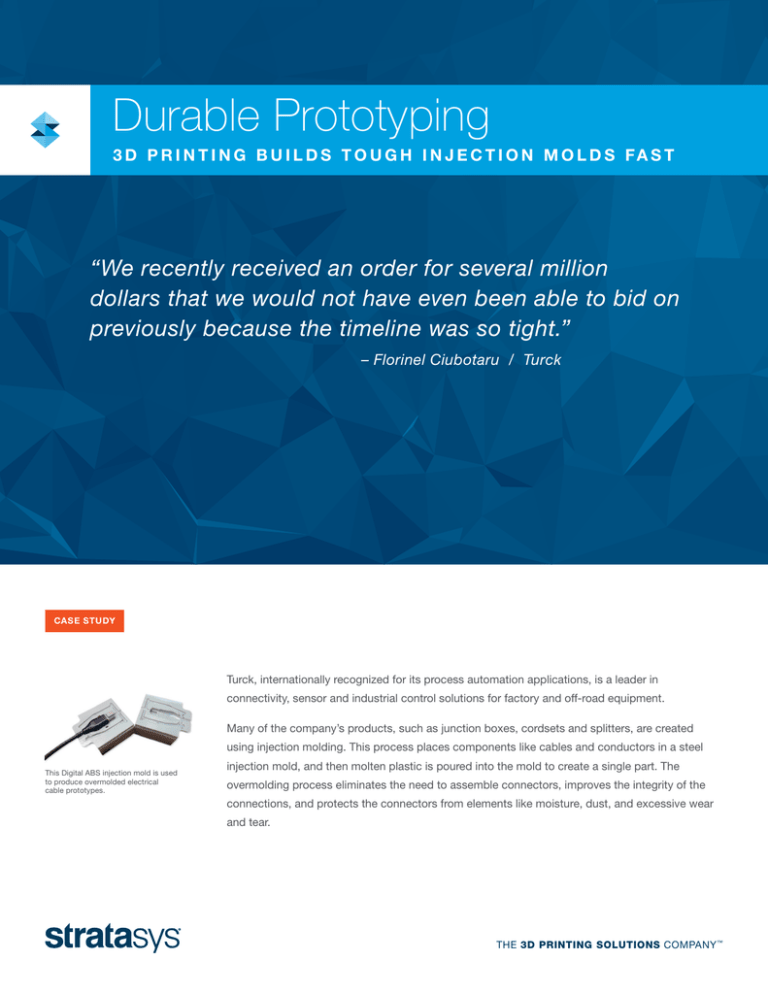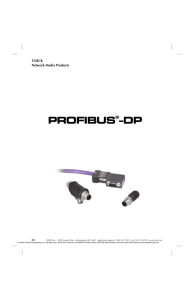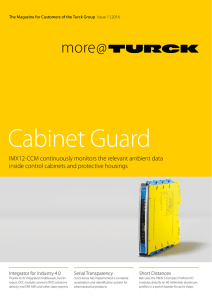
Durable Prototyping
3 D P R I N T I N G B U I L D S T O U G H I N J E C T I O N M O L D S FA S T
“We recently received an order for several million
dollars that we would not have even been able to bid on
previously because the timeline was so tight.”
– Florinel Ciubotaru / Turck
CASE STUDY
Turck, internationally recognized for its process automation applications, is a leader in
connectivity, sensor and industrial control solutions for factory and off-road equipment.
Many of the company’s products, such as junction boxes, cordsets and splitters, are created
using injection molding. This process places components like cables and conductors in a steel
This Digital ABS injection mold is used
to produce overmolded electrical
cable prototypes.
injection mold, and then molten plastic is poured into the mold to create a single part. The
overmolding process eliminates the need to assemble connectors, improves the integrity of the
connections, and protects the connectors from elements like moisture, dust, and excessive wear
and tear.
THE 3D PRINTING SOLUTIONS COMPANY ™
Quicker Customization
Turck offers about 900 overmolded products in its catalog and frequently designs
overmolded parts for custom applications. But before the company can start
producing an overmolded part, prototypes are required to evaluate the product’s
form and fit. The prototypes ensure all critical areas are covered by plastic, and all
accessible connections are free of plastic.
To create a prototype for evaluation, an injection mold must be built. Steel molds
take about 10 weeks to build. On average, two iterations are required during the
design evaluation, and modifying a steel tool takes about a month at a cost of
$5,000. Using this approach, it took Turck about six months to produce a custom
product, which sometimes caused the company to lose orders when the client
needed the product more quickly.
This Digital ABS injection mold is used to produce
overmolded junction box prototypes.
To save time and avoid losing potential clients with custom product requests,
Turck looked to 3D printing.
“The challenge was finding a 3D printing technology strong enough to hold
up to short injection molding runs,” said Florinel Ciubotaru, Turck senior
project manager.
PolyJet™ technology and Digital ABS™ material from Stratasys met
Turck’s challenge.
“Digital ABS provides high-temperature resistance, toughness and rigidity, which
are just what we needed in this application,” Ciubotaru said.
Digital ABS internal mold components can be used to
produce prototypes or low-volume production parts.
Digital ABS can simulate a range of durable production plastics, creating realistic,
precise tools and prototypes that are tough and heat resistant. Using Digital
ABS, Turck produces prototypes for overmolded products just a few days after
completing the design, cutting the time to market to four months instead of six.
The cost of 3D printing the mold is about $1,500, considerably less than the cost
of modifying a steel tool, and the mold can produce between 20 and 100 parts.
The ability to produce prototypes quickly has helped the company get many
orders that it would not have received in the past.
“We recently received an order for several million dollars that we would not
have even been able to bid on previously because the timeline was so tight,”
Ciubotaru said.
More Options Bring More Opportunities
Now Turck can try more design concepts than before thanks to the less
expensive 3D printed molds. With more design freedom, Turck can respond to
customer requests for variants of existing overmolded products. Often these
product modifications have the same external dimensions, but different internal
configurations, such as a bigger connector or cable. In the past, this required
building new internal steel components such as pins and bushings for the mold,
which was an expensive tooling investment.
Complex component molded in a 3D printed mold
THE 3D PRINTING SOLUTIONS COMPANY ™
But with Digital ABS, Turck can build modified internal parts for high- or lowvolume orders. If the part volume is high, prototype components are 3D printed
and the final components are made from steel. If the volume is low, Turck uses the
plastic mold components to make production parts.
The versatility and reliability of 3D printing with Digital ABS have opened the door
to many more opportunities for Turck. From building prototypes quickly to gaining
more design freedom, Turck can handle every custom order with agile expertise.
TIME TO FIRST
PROTOTYPES
TIME TO
MARKET
COST OF TOOLING
ASSUMING 3
ITERATIONS
Build prototypes and
production parts with
steel mold
2.5 months
6 months
$30,000
Build prototypes with
plastic mold and
production parts with
steel mold
2 days
4 months
$23,000
Savings
2.5 months
97%
2 months
33%
$7,000
23%
3D printed mold in the press
HEADQUARTERS
E i n f o @ s t r a t a s y s . c o m / S T R ATA SYS .C O M
7665 Commerce Way,
Eden Prairie, MN 55344
+1 800 801 6491 (US Toll Free)
+1 952 937-3000 (Intl)
+1 952 937-0070 (Fax)
2 Holtzman St., Science Park,
PO Box 2496
Rehovot 76124, Israel
+972 74 745 4000
+972 74 745 5000 (Fax)
ISO 9001:2008 Certified
© 2016 Stratasys Ltd. All rights reserved. Stratasys, Stratasys signet, PolyJet and Digital ABS are trademarks or registered trademarks of Stratasys Ltd. and/or its subsidiaries or affiliates and may be registered in certain jurisdictions. All
other trademarks belong to their respective owners. Product specifications subject to change without notice. Printed in the USA. CS_PJ_CM_Turck_0616a






